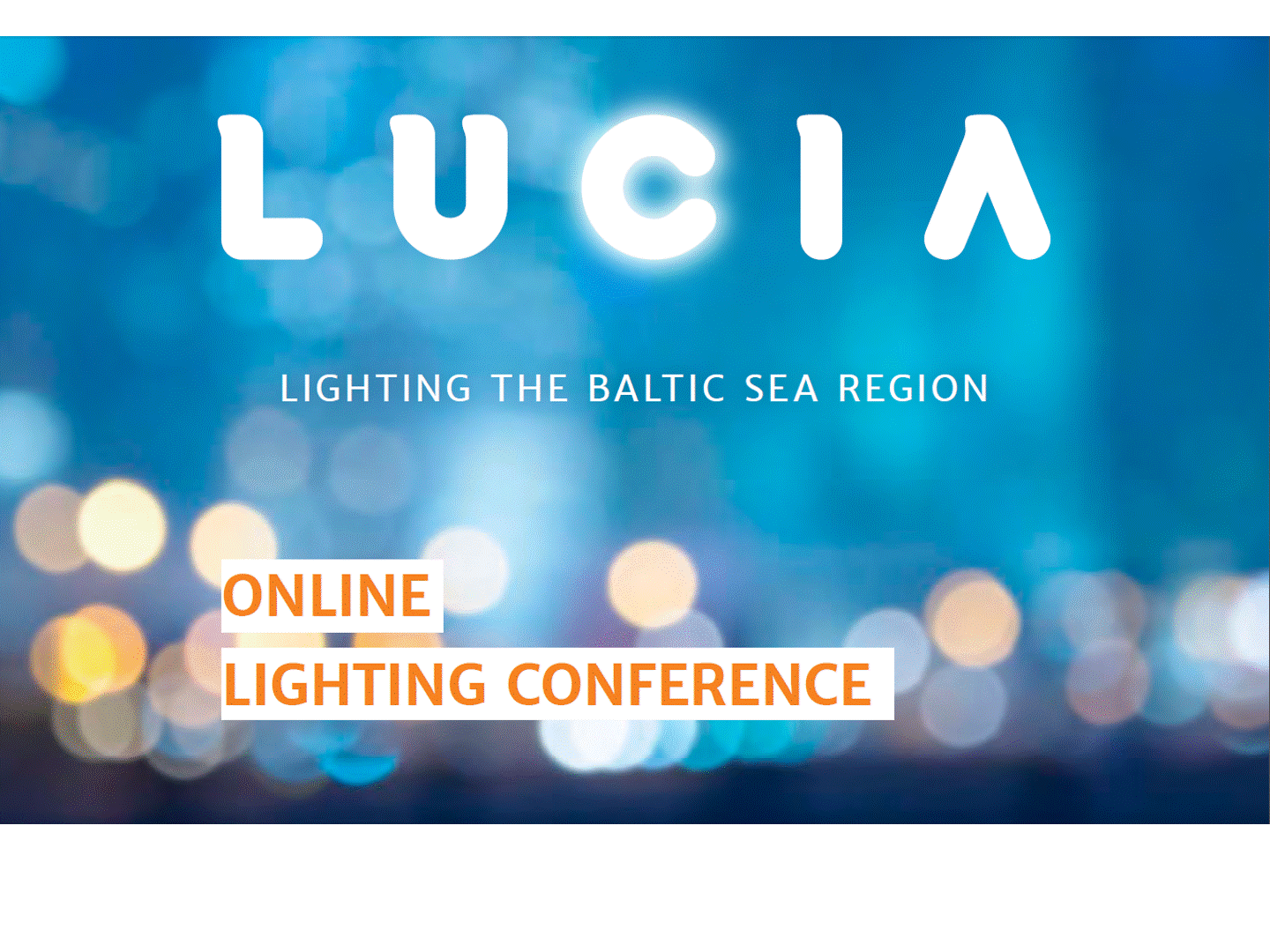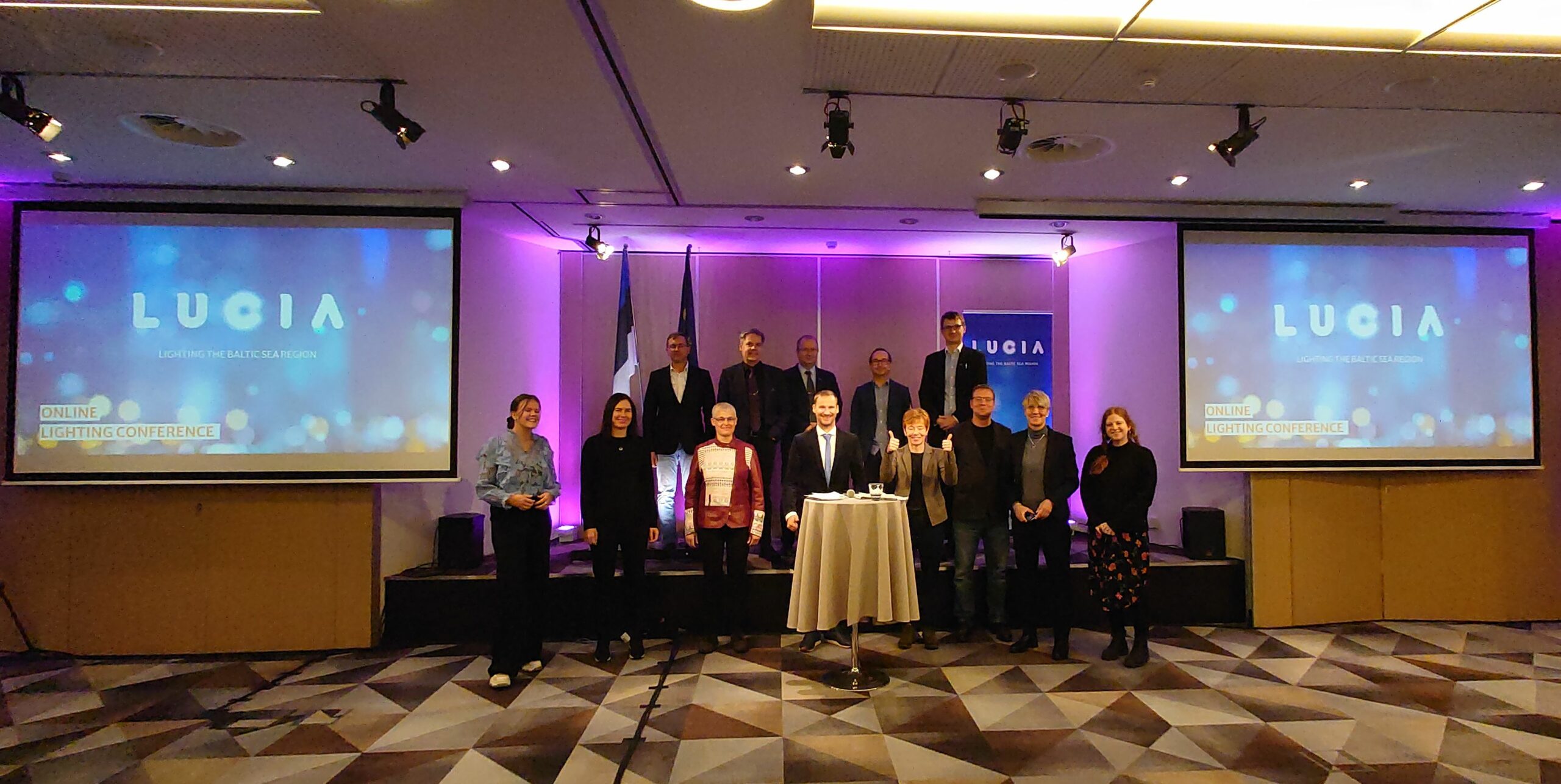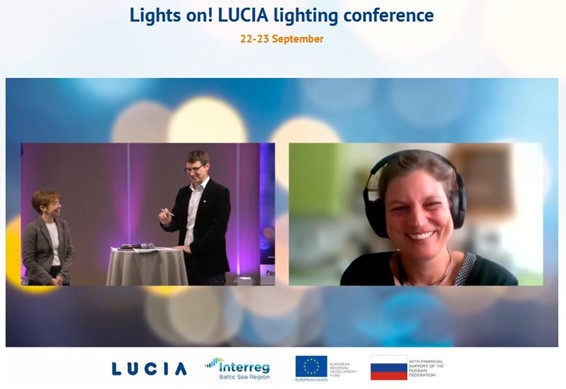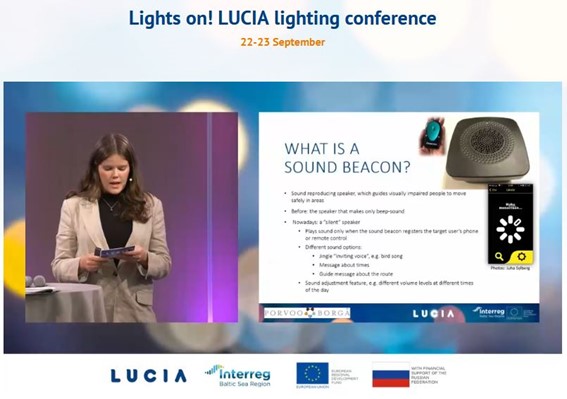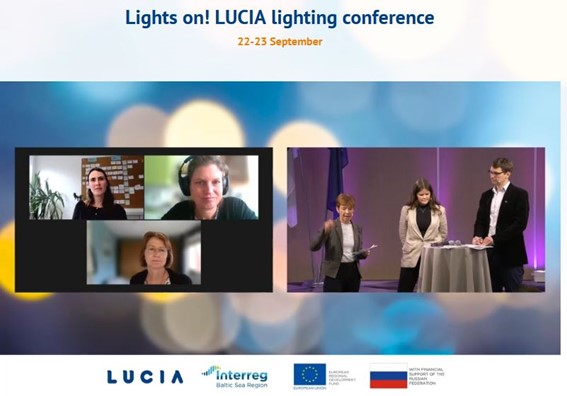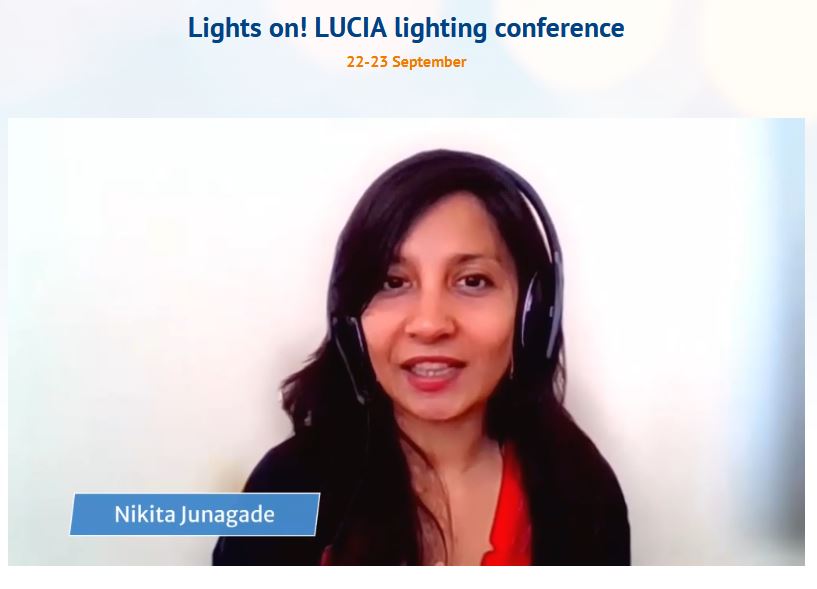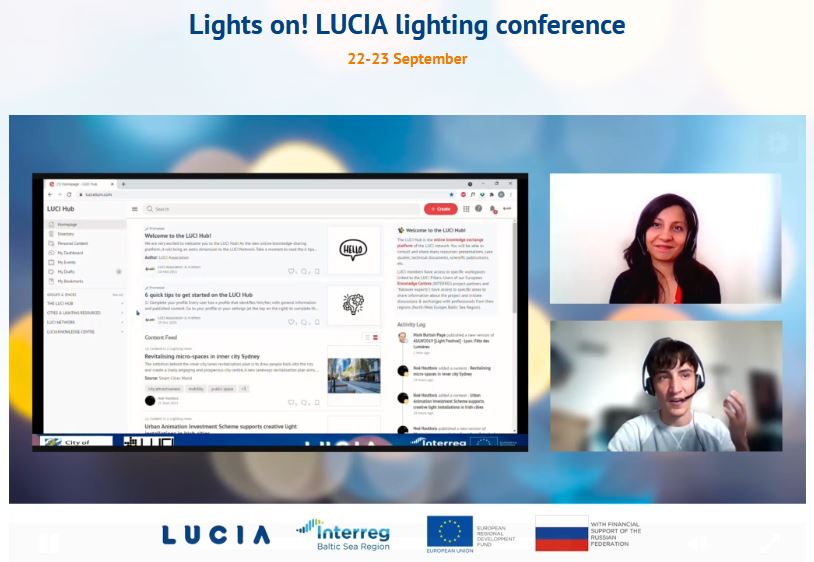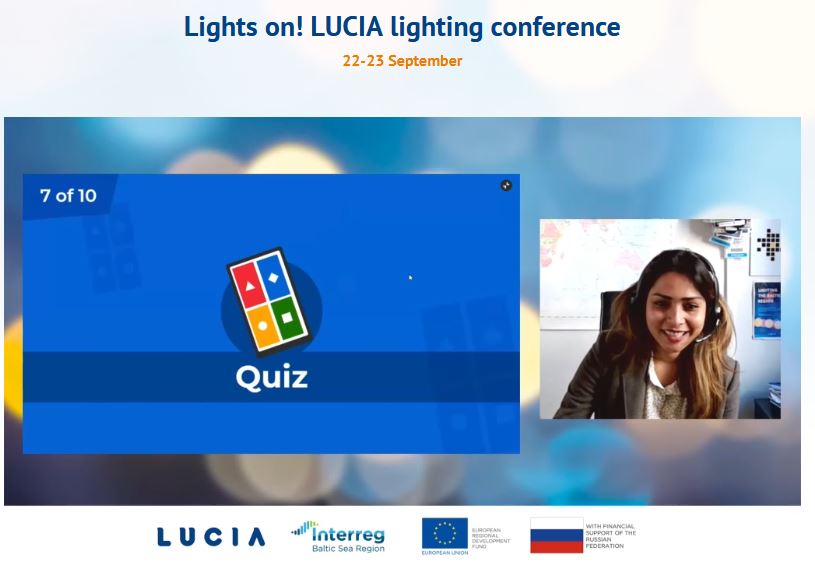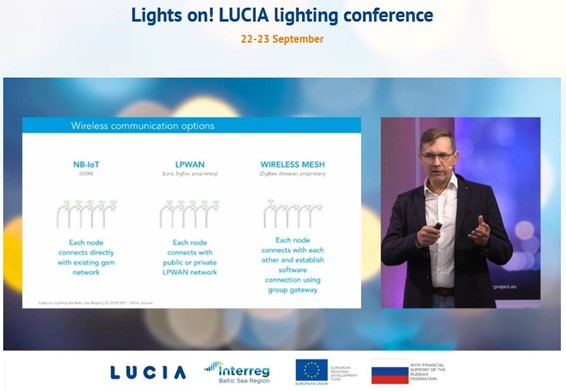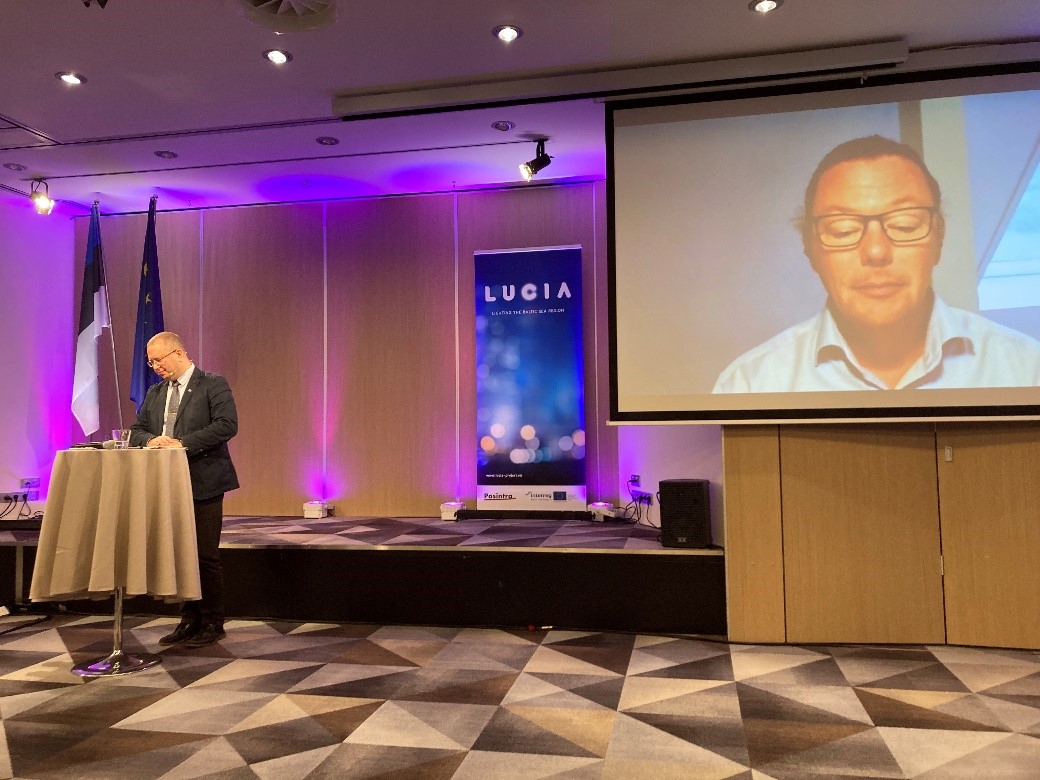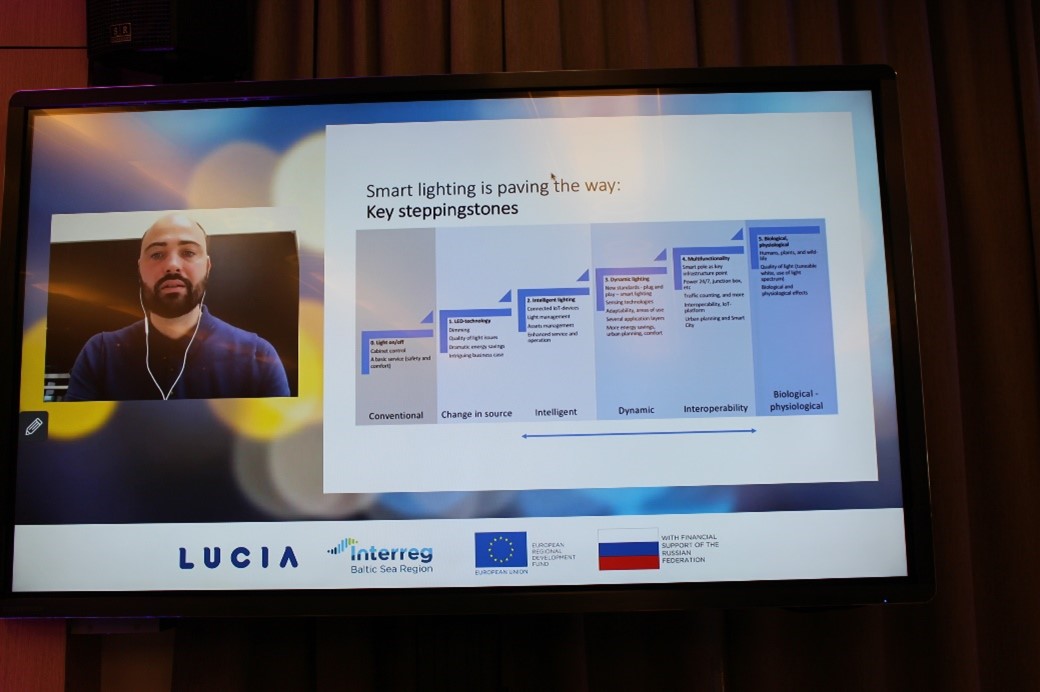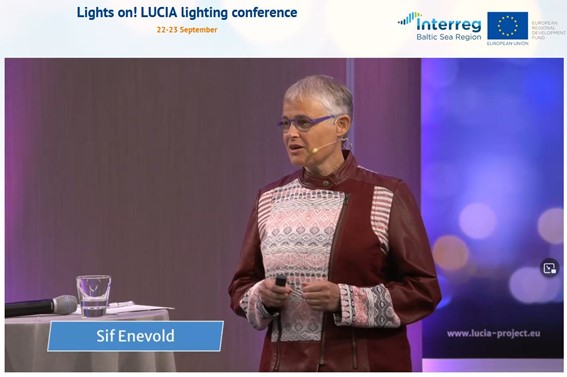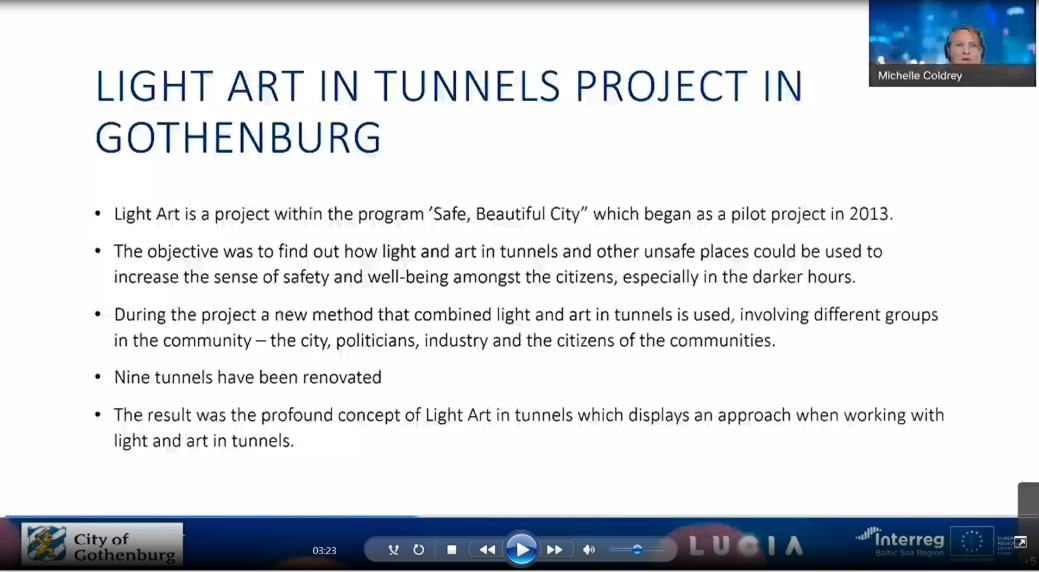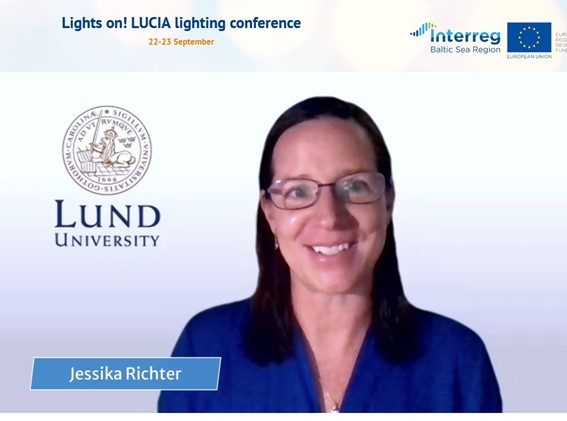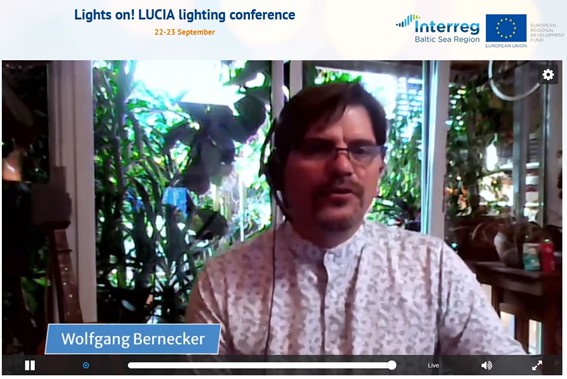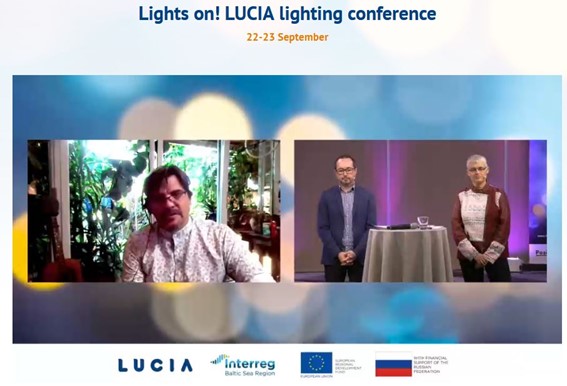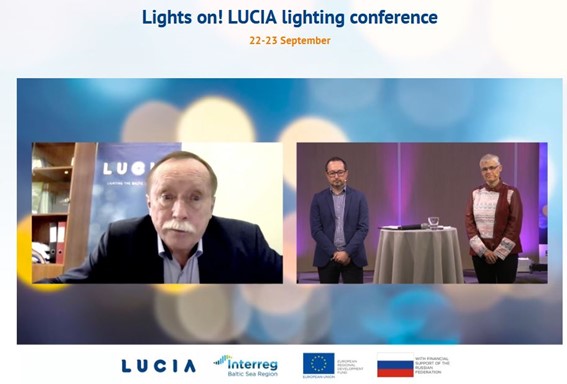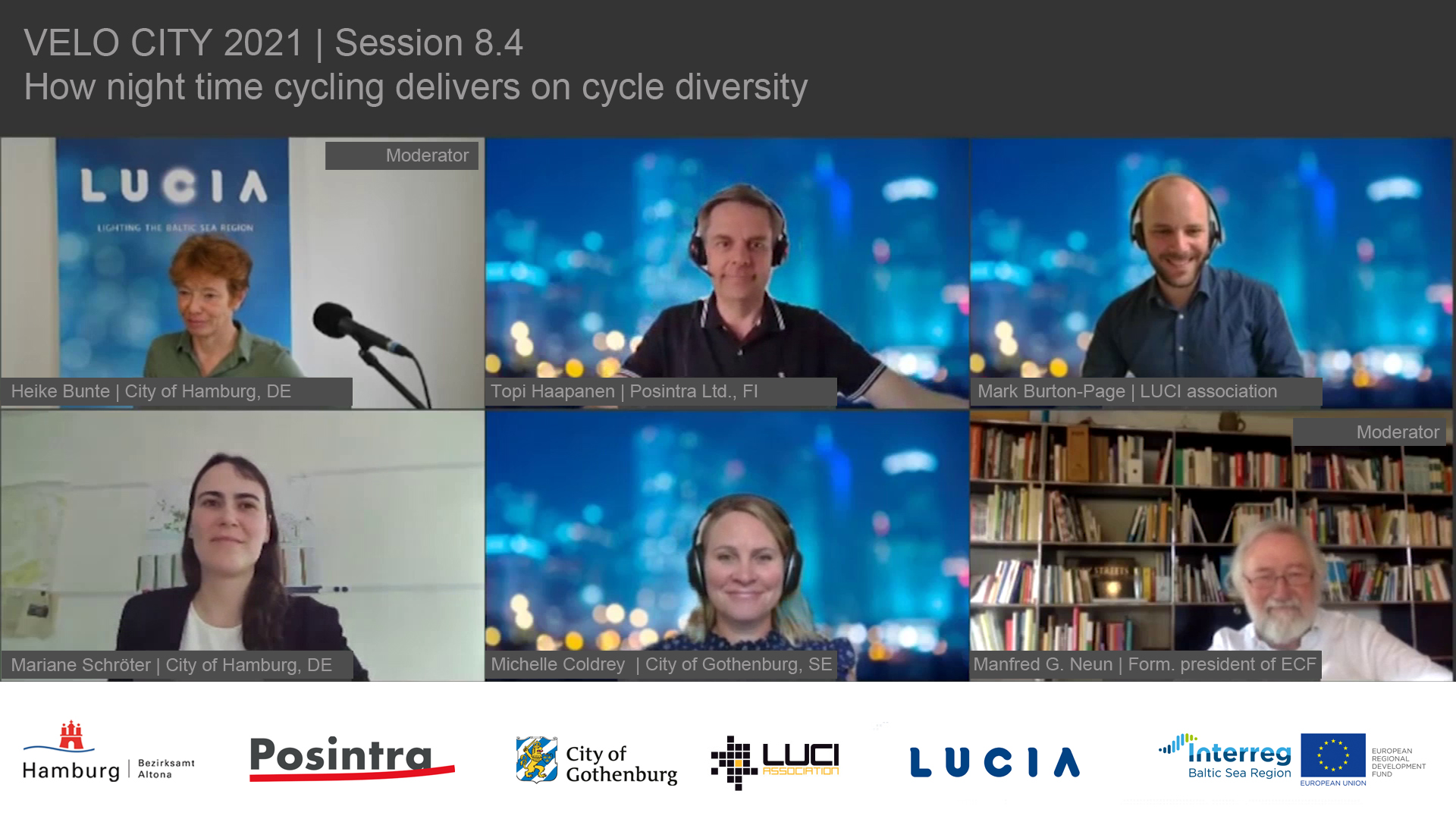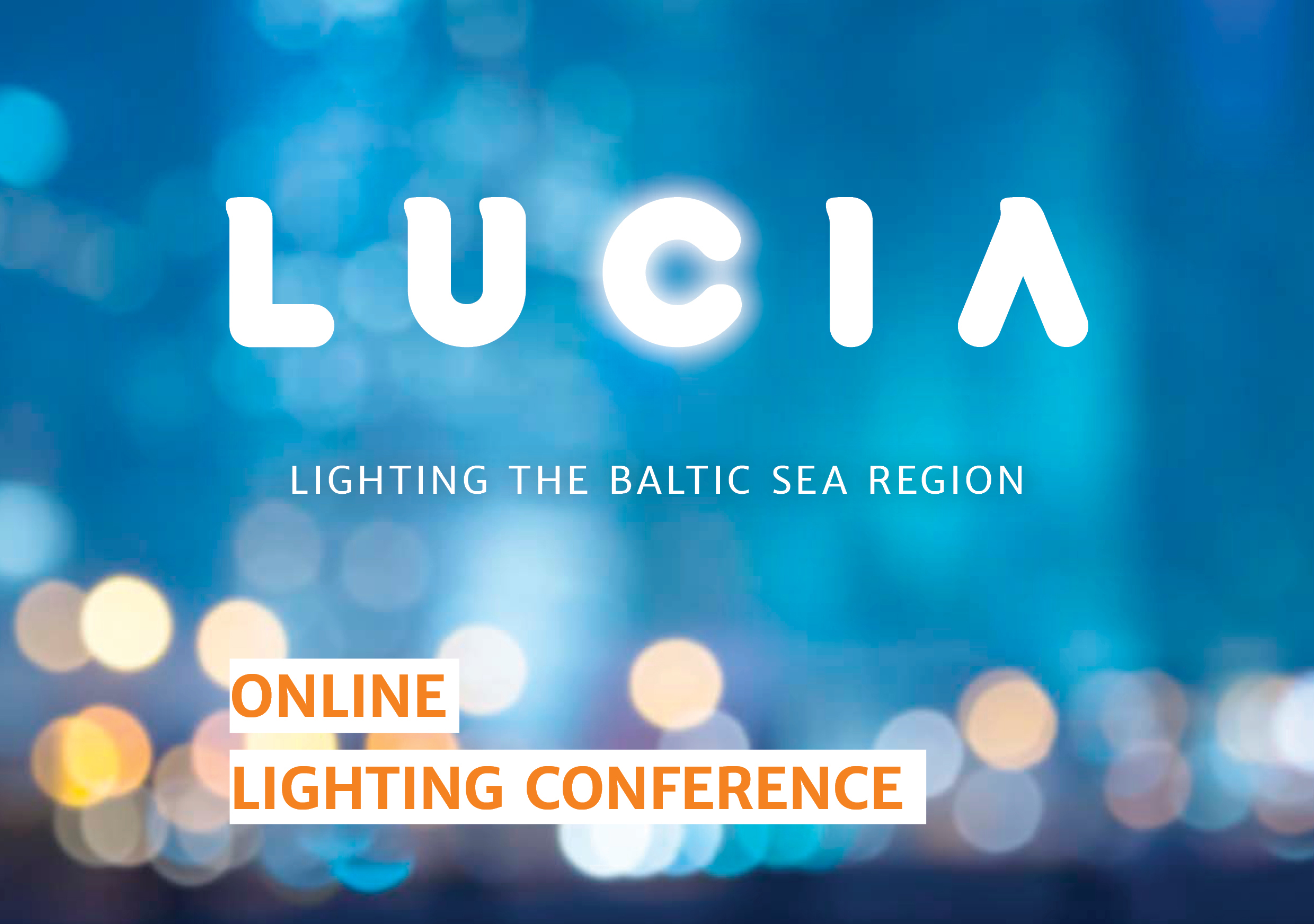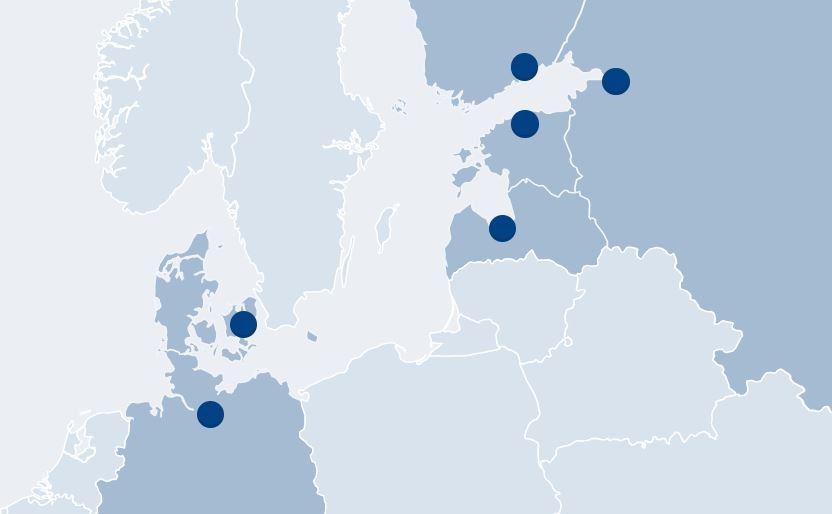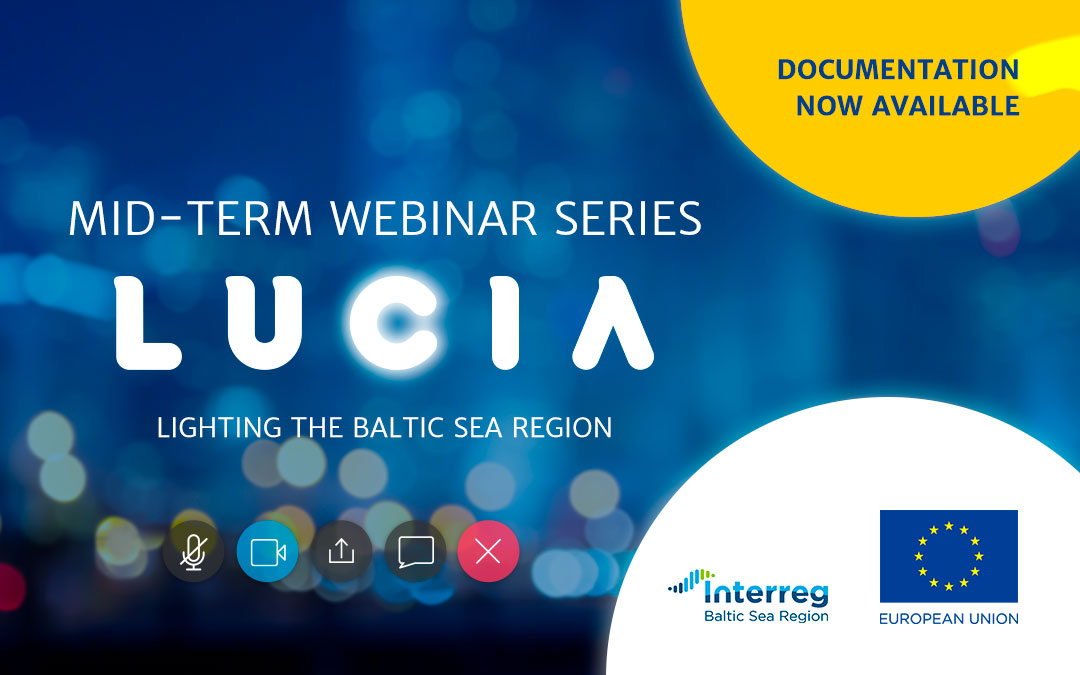In a hybrid format the LUCIA final conference “LIGHTS ON! LIGHTING THE BALTIC SEA REGION” took place physically in Tallinn, Estonia, and online via webinar. More than 200 lighting professionals from different parts of the Baltic Sea region and project partners joined the conference and learned about the different topics of the project as well as the pilot sites in the partner regions.
The pillars of the conference were the following five main sessions:
#1: Ray of Light: HighLIGHTING Economic development in smart urban lighting
#2: Lighten up the day: Interactive Session
#3: Light down? HighLIGHTING Social acceptance, lighting design and darkness in cities
#4: Lights up! HighLIGHTING Technology
#5: Green Light: HighLIGHTING Planning and procurement
Introduction
The day was moderated by Alvar Kurrel (Project Manager, TalTech, Estonia) and Heike Bunte (lead partner, Free and Hanseatic City of Hamburg, Germany). The thematic focus was: How to make the connection between economic development of cities and smart urban lighting but also ways to use urban lighting in public spaces (social acceptance, lighting design and darkness in cities)
This was followed by a introductory speech by Tarmo Sulg (Deputy Head of the Tallinn Municipal Engineering Services, Estonia) and Sven Illing (Vice-Rector for Entrepreneurship, Taltech, Estonia) presenting the host city Tallinn and hosting project partner TalTech as innovative pillars in the country and region.
Speakers and presentations
- Interreg – Highlighting the Baltic Sea Region
Laura Ligazzolo, Interreg Baltic Sea Region – download presentation – see video
The presentation highlights the importance to build on the project achievements in the next Interreg BSR project period and names important dates to keep in mind - Lighting the baltic sea region
Thomas Jacob, Free and Hanseatic City of Hamburg, Senate Chancellery, Germany – download presentation – see video
Introduction of where the LUCIA project started, what the project is all about and what can be next for LUCIA in new Interreg programme period - highLIGHTS! Keynote speach
Meri Lumela, Chair of city council Jyvaskyla, president of LUCI Association – download presentation – see video
The presentation highlights the importance of sustainable urban lighting solutions and the challenge of lighting in the dark such as safety/security, digitalisation, urbanization, climate crisis, competing uses of city by night, active flora and fauna by night
#1: Ray of Light:
HighLIGHTING Economic development in smart urban lighting
Session host: Topi Haapanen, Posintra Ltd., Finland
Session #1 was introduced and moderated by Topi Hapaanen (Director of Regional Development, Posintra Ltd., Finland). Session #1 focused on the link between economic development of cities and smart urban lighting.
Speakers and presentations
- Climate-neutral by 2050 – the (evident) role of cities
Georg Houben, EU Commission’s Directorate General for Energy – download presentation – see video
The presentation explained how making cities smart and climate-neutral, digital solutions, circulation and zero pollution enable new ways of approaching the topics of energy-efficiency, transport and mobility in an urban environment. It also discussed establishing marketplaces in the EU, where smart cities support exchanging and building solutions together. - Lessons learned: Key strategies to link economic development and smart urban lighting
Topi Haapanen, Posintra Ltd., Finland – download presentation – download presentation – see video
The presentation introduced the 20 factsheets that have been created as part of the LUCIA project and how they can help to develop strategies to link economic development and smart urban lighting and support cities/municipalities in working more efficiently. The presentation also stressed that establishing linkage includes looking at financing, procurement, governance as key performance indicators; other indicators to consider: Life-cycle costs, calculations, rebound, risks. - Hosting of the lighting grid – experiences from public-private cooperation
Tero Asikainen, Insplan Ltd., Finland – download presentation – see video
The presentation deals with how cities can profit from a close cooperation with companies that bring smart urban lighting to life, e.g. by having someone by their side being focused on the specific need when it comes to budget, requirements and property management. - Jūrmala pilot – Jomas street
Ieva Šponberga, Development Department, Jūrmala City Council, Latvia – download presentation – see video
The pilot site in Jurmala is built in Jomas street (the central pedestrian street in Jūrmala) which is used by around 3 million people per year. The main goal of the pilot site was the renovation of the illumination on roughly 1 km of the central pedestrian street; about 100 luminaires to be replaced and smart motion sensors will be installed in order to:- Change the brightness of the lighting according to pedestrian flow
- Improve public security
- Provide energy consumption economy, using a dimming function
- Calculated project’s return of investment is expected after 12 years
#2: Light down?
HighLIGHTING Social acceptance, lighting design and darkness in cities
Session host: Heike Bunte, Free and Hanseatic City of Hamburg
Session #2 was introduced and moderated by Tarmo Korõtko (TalTech, Estonia) and Heike Bunte (Free and Hanseatic City Hamburg, Germany). The session focused on the different functions of lighting in public space. Public space has the aim to be accessible for all habitants of an area and to be diverse. Cities need to create awareness for citizens that public spaces benefit them. The following aspects put emphasize on social acceptance, lighting design and darkness in public city spaces.
Speakers and presentations
- Light down! Solutions for sustainable outdoor lighting
Dr. Sibylle Schroer, Leibniz Institute of Freshwater Ecology and Inland Fisheries, Germany – download presentation – see video
The presentation explained how considering the different functions of smart urban lighting in public space is a multidisciplinary effort for cities as it means tackling issues such as climate change, green economy, pollution, safety and security among others at the same time. - Light in motion! Cycle Highway Arnhem-Nijmegen
Anita Stienstra, Province of Gelderland, Netherland – download presentation – see video
The presentation explained how to create new infrastructure in public space, for example cycle highways and use lighting motions to make it more attractive. It also gave practical innovative examples such as how lighting colour can be changed via smartphone by cyclists. - Feel the light! Disabled persons and public lighting
Yolanda Potrykus, City of Porvoo, Finland – download presentation – see video
The presentation dealt with creating inclusive public space for disabled persons by implementing technology (sound beacons); for example, sound reproducing speakers, which guide visually impaired people to move safely in areas. A best practice example was provided by means of the pilot site in Porvoo, Finland. - Pilot Hamburg – Social acceptance of public activities
Mariana Schröter, Free and Hanseatic City of Hamburg – download presentation – see video
The presentation discussed public spaces are diverse areas and how the lack of illumination can e.g. result in fear of safety/security and then encourage vandalism. Vandalism management is challenging for municipal authorities; policy and law enforcement have to get involved and the vandalized public space has to be assessed, monitored and maintained. Increasing social acceptance of public spaces by making them more inviting will reduce vandalism and thus fear of lack of security/safety.
#3: Lighten up the day
Interactive Session
Session host: LUCI Association
Session #3 – an interactive session – was conducted by Shailaja Baichoo, Nikita Junagade, and Noë Hautbois. The sessions included an interactive Quiz to summarize conference Day 1 activities as well as a presentation of LUCIA Knowledge section by LUCI Association: A collaborative tool to build collective knowledge for:
- Ensuring social acceptance and co-creating with citizens
- Activating the city at night
- Smart lighting technologies – building new capacities and knowledge streams
- Multiplicity of solutions and approaches: users to find their individual solution
#4: Lights up!
HighLIGHTING Technology
Session host: Argo Rosin, Vice-Dean for Research in School of Engineering, Tallinn University of Technology
Session #4 was introduced and moderated by Argo Rosin (TalTech) highlighting the importance of a transition from human-centered smart lighting to environmental-friendly adaptive lighting. The session focused on the use of innovative technology in urban lighting.
Speakers and presentations
- The smart city starts with smart lighting
Teddy Sibbern Axelsen, DOLL Living Lab, Denmark – see video
The presentation explained how the lighting industry is a backbone (infrastructure, technology) in smart city development and the different types of smart lighting to be used; how built-in components are pushing standards; and the need for seeing more focus on parameters/that are available maybe virtual reality element. - Smart Street Light Control Systems
Alar Võrk, Lumoflex, Estonia – download presentation – see video
The presentation addressed the question “What should municipalities improve in procurement?” The message was not to focus so much on technical details (what should be in the system like communication technologies), but instead to look into functionality (diming scales, ten steps in dimming schedules, etc., the feasibility to use all the sensors – can they fulfil requirements).- Environment: higher energy-efficiency, reduction of light pollution
- City life: visual comfort, right amount of light when needed and where needed, public safety
- City management: daily reports on operational status, maintenance savings, high return on investment
- Albertslund pilot – Activity-based lighting solutions in DOLL Living Lab
Videopresentation followed by Søren Refsgaard, Product Manager, Seneco a/s, Denmark – download presentation – see video
The presentation highlighted the advantages of using activity-based lighting solutions e.g. motion detection for connected solutions provides luminaire controllers for:
#5: Green Light:
HighLIGHTING Planning and procurement
Session host: Sif Enevold, Chief Project Manager, Gate 21, Denmark – download presentation
Session #5 was introduced and moderated by Sif Enevold (Chief Project Manager, Gate 21, Denmark) and Yannick Le Moullec (Tenured Associate Professor, TalTech, Estonia). The session focused on new and innovative ways to planning and procurement of smart urban lighting. Sif Enevold introduced the session.
Speakers and presentations
- Göteborg towards smart and sustainable lighting
Michelle Coldrey, City of Gothenburg, Sweden – download presentation – see video
The presentation explained the importance of combining art and lighting when implementing smart urban lighting in tunnels helps to make them an attractive public space people want to use. - Life cycle and green procurement towards sustainable lighting
Jessika Richter, Postdoctoral Fellow, Lund University, Sweden – download presentation – see video
The presentation explained that GPP is a voluntary process for procuring goods and services with a reduced environmental impact throughout their lifecycle; the aim is to lead, demonstrate, and incentivise greener products and services with a focus on other life-cycle stages than energy-efficiency. The presentation also explained that on the EU level, it is not mandatory to do GPP, however standards for sustainable criteria in procurement have increased:- Increasing requirements for repairability, maintenance and warranty
- Increasingly other environmental impacts considered
- Lighting pollution minimisation
- Sustainable Production and Consumption
- Material passports for more transparent supply chains and better recycling
- Procurement of lighting as a service
- Planning with Virtual Reality lighting solution
Wolfgang Bernecker, FuctureAct, Germany – download presentation – see video
The presentation introduced a virtual reality tool to help the planning process for making urban lighting more interactive, for example changing day or night-time; changing the season; changing the weather conditions; when should the light switch on when the sun rises; reaction to traffic; people passing in different speeds; light colours etc. It should be noted that the tool is available as open source and easy to use; thus, municipalities can get a quick understanding of how to use such tools for planning before procurement. - St. Petersburg pilot – SPbPU campus
Yuri Nurulin, Peter the Great St. Petersburg Polytechnic University, Russia – download presentation – see video
The pilot in St. Petersburg is all about innovative solutions for an energy-efficient outdoor lighting of a park alley at campus of Peter the Great St. Petersburg Polytechnic University (SPbPU). Some central issues include the fact that modernization in a historic environment needs special permission but also should fit into the already existing design. Also, a holistic approach should be used for outdoor lighting as a socio-technical system. In total, there will be 22 multifunctional and smart illuminations as well as artistic illuminations that provide energy saving solutions and improve the level of comfort and perceived safety on the campus.
Conclusion
The LUCIA final conference concluded the project in a very positive way. All project partners, associated organizations, and stakeholders created and obtained new knowledge about todays’ best practices and future opportunities to accelerate the deployment of sustainable and smart urban lighting solutions.
